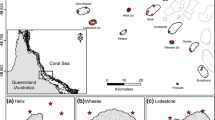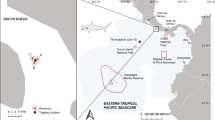Abstract
The movement patterns and long-term site-fidelity of primarily juvenile Caribbean reef sharks, Carcharhinus perezi, were investigated using tag-recapture and automated telemetry at an insular nursery area, the Fernando de Noronha Archipelago, Brazil. Of the 143 externally tagged juvenile sharks (<110 cm), 22 (15.3%) were recaptured between 0 and 5 km from the site of tagging after 5–800 days at liberty, suggesting some site-fidelity in young individuals of this species. Site-fidelity and movement patterns of ten juvenile sharks ranging from 78 to 110 cm total length (TL) and one opportunistically captured adult female (224 cm TL) were also investigated for periods of up to 2 years with an array of automated telemetry receivers. Tagging and telemetry data from both inside and outside a marine protected area (MPA) show that shark abundance and activity is greatest along the part of the archipelago’s coastline least disturbed by human activity. Telemetry tracking also showed that juvenile reef sharks demonstrated a high degree of site-fidelity and occupied specific locations along the coast throughout the year, with some evidence of an increase in activity space with ontogeny. Sharks appeared to range more widely at night and there were no seasonal variations in habitat use. Our results suggest that MPAs may be a useful conservation tool to protect young C. perezi and potentially other reef-dwelling carcharhinid sharks during their early life history.






Similar content being viewed by others
References
Barker MJ, Schluessel V (2005) Managing global shark fisheries: suggestions for prioritizing management strategies. Aquat Conserv Marine Freshw Ecosyst 15:324–347
Bascompte J, Melián CJ, Sala E (2005) Interaction strength combinations and the overfishing of a marine food web. Proc Natl Acad Sci USA 102(15):5443–5447. DOI 10.1002/aqc.660
Baum JK, Myers RA, Kehler DG, Worm B, Harley SJ, Doherty PA (2003) Collapse and conservation of shark populations in the Northwest Atlantic. Science 299:389–392
Bonfil R (1997) Status of shark resources in the Southern Gulf of Mexico and Caribbean: implications for management. Fish Res 29:101–117
Bonfil R (1999) Marine protected areas as shark fisheries management tool. In: Seret B, Sire J-Y (eds) Proceedings of the 5th Indo-Pacific fish conference, Noumea, New Caledonia, 3–8 November 1997. Societe Francaise d’Ichtyologie, Paris and Istitut de Recherche pour le Developpement, Paris, pp 217–230
Carrier JC, Pratt HL (1998) Habitat management and closure of a nurse shark breeding and nursery ground. Fish Res 39:209–213
Chapman DD, Pikitch EK, Babcock EA, Shivji MS (2005) Marine reserve design and evaluation using automated acoustic telemetry: a case study involving coral-reef associated sharks in the Mesoamerican Caribbean. In: Lindholm J (ed) Special issue—acoustic tracking of marine fishes: implications for the design of marine protected areas. Marine Technol Soc J 39(1):42–56
Compagno LJV (1984) FAO species catalogue, vol 4. Sharks of the world. An annotated and illustrated catalogue of sharks species known to date. Part 2. Carcharhiniformes. FAO Fish Synop 125
Compagno LJV (2002) Carcharhinidae. In: Carpenter KE (ed) The living marine resources of the Western Central Atlantic, vol 1. Introduction, molluscs, crustaceans, hagfishes, sharks, batoid fishes, and chimaeras. FAO species identification guide for fisheries purposes and American Society of Ichthyologists and Herpetologists Special Publication No. 5. FAO, Rome, p 486
Garla RC (2004) Ecologia e conservação dos tubarões do Arquipélago de Fernando de Noronha, com ênfase no tubarão-cabeça-de-cesto, Carcharhinus perezi (Carcharhiniformes: Carcharhinidae) (in Portuguese). Unpublished PhD thesis, Universidade Estadual Paulista
Gruber SH, Nelson DR, Morrissey JF (1988) Patterns of activity and space utilization of lemon sharks, Negaprion brevirostris, in a shallow Bahamian lagoon. Bull Mar Sci 43:61–76
Gruber SH, De Marignac JRC, Hoenig JM (2001) Survival of juvenile lemon sharks at Bimini, Bahamas, estimated by mark-depletion experiments. Trans Am Fish Soc 130:376–384
Henningsen AD (1994) Tonic immobility in 12 elasmobranchs: use as an aid in captive husbandry. Zoo Biol 13:325–332
Heupel MR, Hueter RE (2002) Importance of prey density in relation to the movement patterns of juvenile blacktip sharks (Carcharhinus limbatus) within a coastal nursery area. Mar Freshw Res 53:543–550
Heupel MR, Simpfendorfer CA (2002) Estimation of mortality of juvenile blacktip sharks, Carcharhinus limbatus, within a nursery area using telemetry data. Can J Fish Aquat Sci 59:624–632
Heupel MR, Simpfendorfer CA (2005) Using acoustic monitoring to evaluate MPAs for shark nursery areas: the importance of long term data. In: Lindholm J (ed) Special issue—acoustic tracking of marine fishes: implications for the design of marine protected areas. Marine Technol Soc J 39(1):10–19
Holland KN, Wetherbee BM, Peterson JD, Lowe CG (1993) Movements and distribution of hammerhead shark pups on their natal grounds. Copeia 1993:495–502
Holland KN, Lowe CG, Wetherbee BM (1996) Movements and dispersal patterns of blue trevally (Caranx melampygus) in a fisheries conservation zone. Fish Res 25:279–292
Klimley AP, Butler SB, Nelson DR, Stull AT (1988) Diel movements of scalloped hammerhead sharks, Sphyrna lewini to and from a seamount in the Gulf of California. J Fish Biol 33:751–761
Kohler NE, Turner PA (2001) Shark tagging: a review of conventional methods and studies. Environ Biol Fishes 60:191–223
Lindholm J (2005) Acoustic tracking of marine fishes: implications for the design of marine protected areas. Mar Technol Soc J 39(1):7–10
Maida M, Ferreira BP (1997) Coral reefs of Brazil: an overview. In: Proceedings of the 8th international coral reef symposium, vol 1, pp 263–274
McKibben JN, Nelson DR (1986) Patterns of movement and grouping of gray reef sharks, Carcharhinus amblyrhynchos, at Enewetak, Marshall islands. Bull Mar Sci 38:89–110
Merson RR, Pratt HL Jr (2001) Distribution, movements and growth of young sandbar sharks, Carcharhinus plumbeus, in the nursery grounds of Delaware Bay. Environ Biol Fishes 61:13–24
Morrissey JF, Gruber SH (1993) Home range of juvenile lemon sharks, Negaprion brevirostris. Copeia 1993:425–434
Nelson DR (1990) Telemetry studies of sharks: a review, with applications in resource management. NOAA Tech Rep NMFS 90, pp 239–256
Sazima I, Moura RL (2000) Shark (Carcharhinus perezi), cleaned by the goby (Elacatinus randalli), at Fernando de Noronha archipelago, Western South Atlantic. Copeia 2000:297–299
Sobel J, Dahlgren C (2004) Marine reserves: a guide to science, design and use. Island Press, Washington, 383 pp
Stevens J (2002) The role of protected areas in elasmobranch fisheries management and conservation. In: Fowler SL, Reed JM, Dipper FA (eds) Elasmobranch biodiversity, conservation and management. Proceedings of the international seminar and workshop, Sabah, Malaysia, July 1997. IUCN SSC Shark Specialist Group. IUCN, Gland, Switzerland, xv+258 pp
Watts S (2001) The end of the line? In: Knights P, Williams J (eds) WildAid report. Wendy P. Mc Caw Foundation. http://www.wildaid.org (access in February 2004)
Acknowledgments
This study formed part of the PhD research of R.C. Garla who thanks his advisor, A.F. Amorim, for general advice and valuable suggestions. This research collaboration was supported by fellowships provided by São Paulo’s Research Support Foundation (FAPESP), Fundação O Boticário de Proteção à Natureza/J.D. & C.T. McArthur Foundation and International Society for Reef Studies (to RG), Wildlife Conservation Society (to RG and DC) and the National Science Foundation (to DC). The Brazilian Environmental Agency (IBAMA) and the General Administration of the State District of Fernando de Noronha provided research permits. This international collaboration was inspired by S. Gruber, E. Pikitch and R. Rosa. Finally, we thank L. Veras for initial logistic support, O.J. Souza for lending his boat for shark fishing in 2000 and many field volunteers including D. Abercrombie, B. Victor, C.L.B. Francini, R. Coluchi, N.P. Lopes, R.H.A. Freitas, L.F. Mendes and T. Guaratini, who made this project possible.
Author information
Authors and Affiliations
Corresponding author
Additional information
Communicated by O. Kinne, Oldendorf/Luhe
Rights and permissions
About this article
Cite this article
Garla, R.C., Chapman, D.D., Wetherbee, B.M. et al. Movement patterns of young Caribbean reef sharks, Carcharhinus perezi, at Fernando de Noronha Archipelago, Brazil: the potential of marine protected areas for conservation of a nursery ground. Marine Biology 149, 189–199 (2006). https://doi.org/10.1007/s00227-005-0201-4
Received:
Accepted:
Published:
Issue Date:
DOI: https://doi.org/10.1007/s00227-005-0201-4




